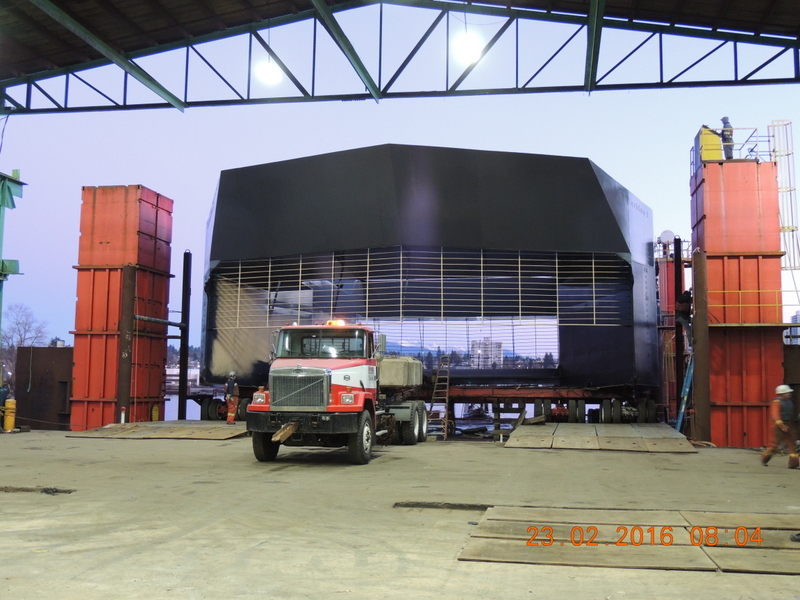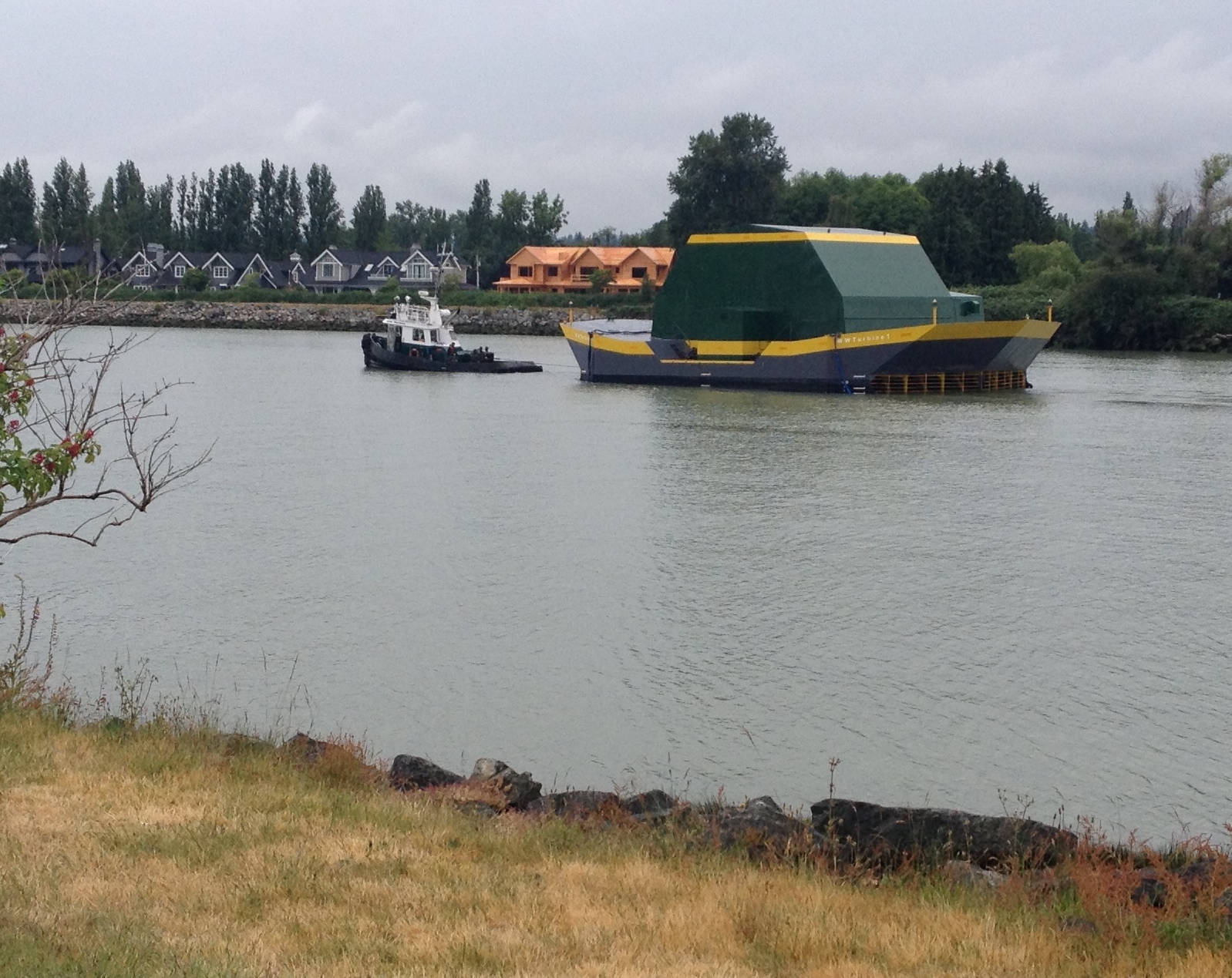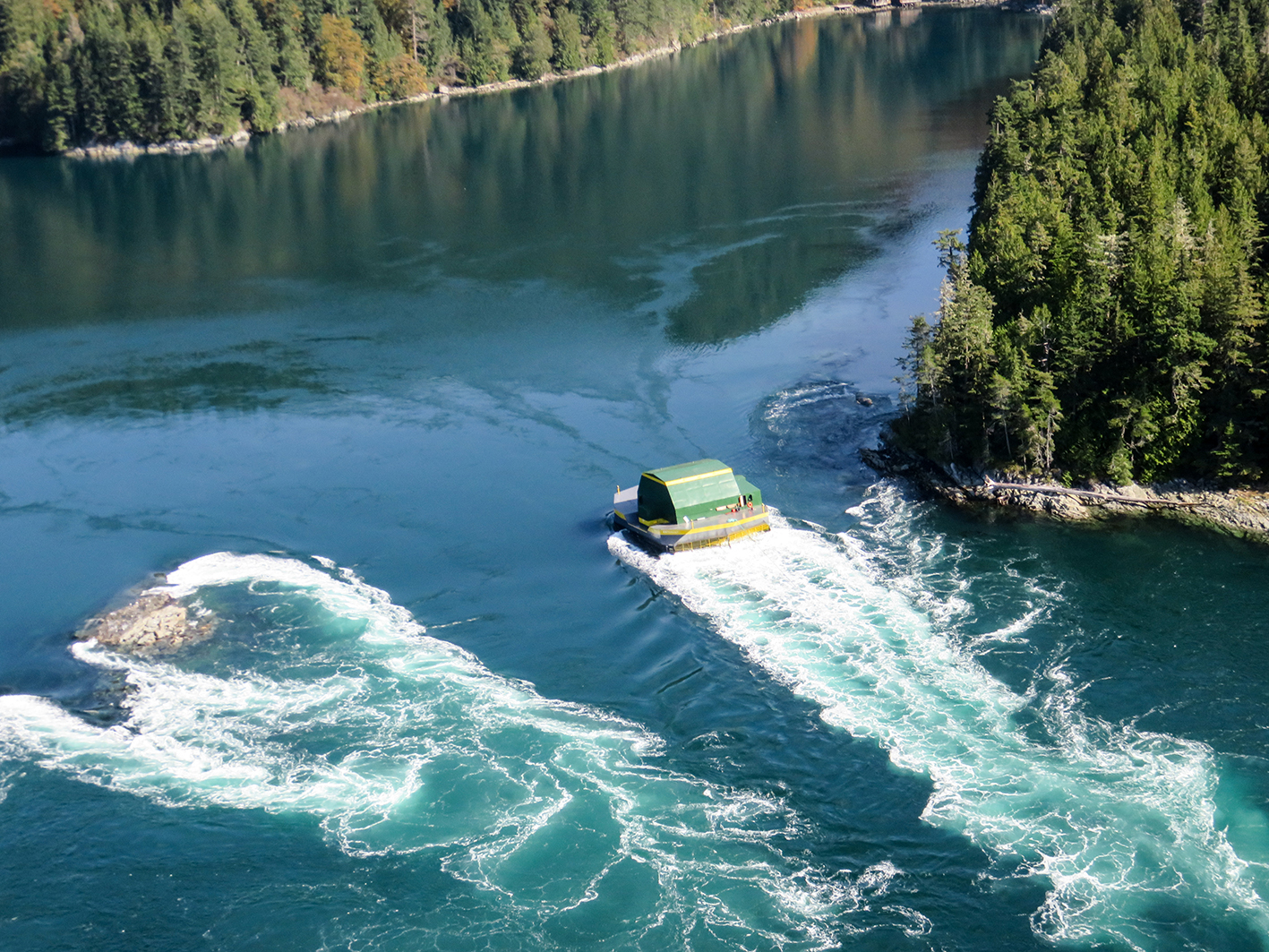Water Wall Turbine Dent Island Tidal Power Generation Project
Lead Proponent: Water Wall Turbine Inc.
Location: Lions Bay, British Columbia
CEF Contribution: $2,250,000
Project Total: $5,179,000
Project Background

Water Wall Turbine Inc.’s vessel being moved from the fabrication shop to dry dock before being tested in the Vancouver area. February 23, 2016.
In the fall of 2012, ecoEII awarded $300,000 to Water Wall Turbine (WWT) for a Front End Engineering and Design (FEED) study of a 500 kW floating tidal turbine power plant for Dent Island Lodge off the west coast of British Columbia – the Dent Island Tidal Power Generation Project. The FEED study enabled WWT to complete substantial work on the system design and site analysis. Credibility was gained with potential investors, as well as sub-contractors in the supply chain. The proponent, WWT was subsequently awarded $2,250K from CEF to complete the final design, construct and commission a tidal energy system for Dent Island Lodge.
Results
WWT’s tidal energy system combined 3 major sub-systems: a floating tidal turbine, a proprietary microgrid management system and an energy storage system.
The floating tidal turbine consists of an anchored 550-tonne 28x17-metre catamaran-like barge that houses a large 72-tonne paddle wheel turbine. The 1MW turbine rotates at less than 12 revolutions per minute (RPM) and is designed using WWT’s patented technology that extracts not just the kinetic energy, but also the latent potential energy of fast moving currents (up to 7 metres per second) by operating on the surface where currents are strongest. The turbine therefore provides high energy extraction efficiency; almost double that of conventional propeller-driven devices. The shaft of the turbine’s paddle wheel is connected to a 500kWh power system - gearbox and generator. A shipyard and a manufacturing company spent a year fabricating the floating vessel and the turbine. More than 30,000 person-hours of labour went into the fabrication process. Once the assembly of the vessel was completed, the turbine was installed in the housing and all other mechanical and electrical equipment was assembled. The floating turbine subsystem underwent initial testing on the Fraser River in Vancouver.

The Water Wall Turbine being towed from Richmond, BC along the North Arm of the Fraser River, towards Dent Island.
A remote “islanded” microgrid system was designed and developed to enable Dent Island to manage tidal generation, 500 kWh energy storage and emergency back-up diesel. Microgrid management uses energy storage to provide continuous power during slack tidal periods and facilitates the integration of multiple sources of power to provide for peak periods. A custom interface was developed between WWT’s microgrid management system and Tesla’s energy storage management system, as well as a specialty on-vessel current converter . The microgrid and energy storage systems were installed on Dent Island.
In June 2016, the turbine vessel was towed along the Strait of Georgia to Dent Island. There, it was anchored in a narrow channel between the islands. A unique mooring and anchoring system had been developed to keep the turbine vessel at station under tremendous force - over 100 tonnes in alternating directions 4 times a day. Installation of the system required special improvised techniques to secure the anchor points during short 15 minute slag intervals between strong tidal currents (exceeding 10 knots). The turbine vessel was then connected via a 900-meter submarine cable running along the ocean floor to Dent Island’s microgrid and energy storage system.
During the microgrid test and installation phases, real time performance data was collected. Net power production was delivered with limited turbine blades submersion. The short preliminary testing period was completed. Extrapolating both current speed and optimal blade submersion depth produces total power potential beyond initial expectations. Theoretical values will be confirmed once the turbine is returned to service in June 2017.

The WWT Power Plant installed and supplying electricity to Dent Island Lodge via WWT Microgrid & Energy Storage systems
Benefits to Canada
The newly commissioned tidal turbine, complete with microgrid and energy storage, provides a showcase for the commercial development of tidal energy. The technologies developed and tested will advance the use and adoption of tidal energy in Canada and around the world.
Next Steps
Full testing and monitoring of the system at Dent Island will resume June to September 2017, during lodge’s operating season. Data collected will be used to improve subsequent design iterations of WWT’s system.
Page details
- Date modified: